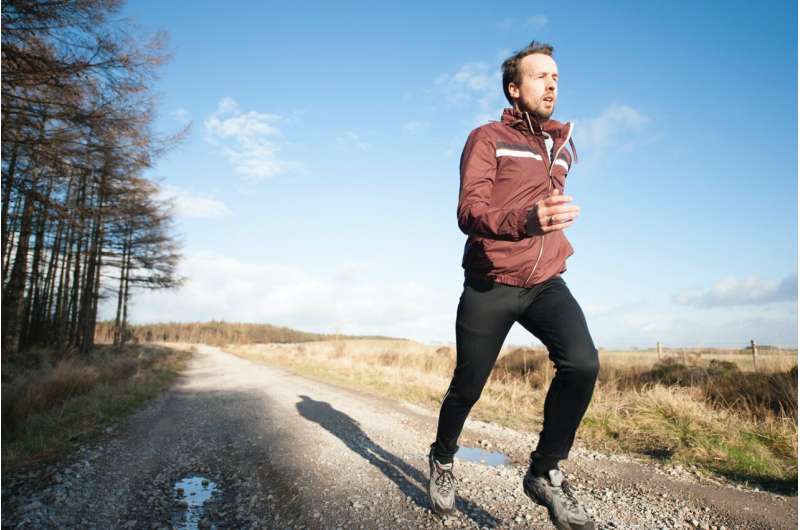This article has been reviewed according to Science X's editorial process and policies. Editors have highlighted the following attributes while ensuring the content's credibility:
fact-checked
peer-reviewed publication
trusted source
proofread
Study shows morning and afternoon slightly better than evening physical activity for diabetes prevention

New research published in Diabetologia shows that morning and afternoon physical activity are associated with a lower risk of developing type 2 diabetes across all population levels of education and income, but has found no statistically significant association between evening physical activity and risk type 2 diabetes. The study is by Dr. Caiwei Tian, Harvard University, Cambridge, MA, U.S., and Dr. Chirag Patel, Harvard Medical School, Boston, MA. and colleagues.
Physical activity is a preventive factor for type 2 diabetes, but its timing and consistency (in contrast with overall sum of physical activity) has been relatively unexplored. Accelerometer-based devices that measure physical activity provide a new opportunity to objectively measure behavior throughout the day and week.
It has been shown that midday–afternoon but not evening physical activity is associated with a lower risk of mortality compared with morning physical activity, but the relationship with type 2 diabetes remains understudied. In this new study, the authors analyzed the relationship between morning, afternoon, or evening physical activity and consistency (routine) and risk of type 2 diabetes.
A cohort of 93,095 UK Biobank participants (mean age 62 years) without a history of type 2 diabetes wore a wrist-worn accelerometer for one week. The authors converted accelerometer information to estimate metabolic equivalent of task (MET) (a common measure of physical activity), adding up MET-hours of total physical activity.
MET-hour physical activity captures all types of activity undertaken by an individual throughout the day and measured with the accelerometer, including chores, walking, and vigorous activity. The authors measured completed METs within three time segments (morning, afternoon, and evening), divided as 06:00–12:00 hours (morning); 12:00–18:00 hours (afternoon); and 18:00–24:00 hours (evening).
The authors quantified the consistency of physical activity by analyzing the variance (difference) of each person's activity from their own personal average. Those with smaller deviations were more consistent and vice versa. The authors also considered the intensity of exercise: moderate-to-vigorous physical activity (MVPA) and vigorous physical activity (VPA) in association with type 2 diabetes incidence.
The authors observed protective associations of physical activity, with each 1-unit increase in MET being associated with a 10% and 9% reduction in risk of type 2 diabetes in the morning and afternoon, respectively. However, there was no statistically significant association between evening physical activity and risk of type 2 diabetes.
The relationship with morning and afternoon physical activity was largely linear, meaning that those people with more MET-h completed had a much lower risk of developing type 2 diabetes than those with less (10% / 9% per MET-h, for morning and afternoon respectively).
The authors believed that lifestyle factors, such as amount of sleep and dietary intake, would influence the amount of physical activity in the morning, afternoon, and evening undertaken, and therefore the role activity has in diabetes risk. To address how these factors influenced physical activity, the authors considered them in their analytic models. They found that when adjusting for lifestyle factors, associations for MET-hours with different times of day became more precise.
Consistency of MET-measured physical activity was not associated with type 2 diabetes, but intensity was; both MVPA and VPA were associated with decreased risk for type 2 diabetes at all times of the day.
The authors say their study is the first report on the effect of consistency of activity, and explain, "The consistency or routine of physical activity was not strongly associated with type 2 diabetes. In other words, individuals who exercise a smaller amount of time more frequently are at no lesser risk for diabetes than individuals who exercise the same total amount, but with less of a routine."
Unlike previous studies, the authors highlight that one of the strengths of this new research is that they used the MET h as the objective physical activity measurement to take all daily activities into account. Their results were also statistically significant after adjusting for other lifestyle variables including sleep, diet, education and income.
The authors conclude, "Our findings support that total physical activity, but not its consistency over the week, may be an important factor impacting type 2 diabetes risk. The timing of activity may play a role in mitigation of diabetes risk."
They add, "Our study showed an association with diabetes risk between morning and afternoon versus evening physical activity. The findings also suggest it is helpful to include some higher-intensity activity to help reduce the risk of developing diabetes and other cardiovascular disease."
More information: Caiwei Tian et al, Association between timing and consistency of physical activity and type 2 diabetes: a cohort study on participants of the UK Biobank, Diabetologia (2023). DOI: 10.1007/s00125-023-06001-7





















